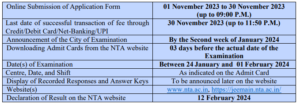Sub: Inviting Online Application Forms for Joint Entrance Examination (Main) – 2024 – Reg
JEE Paper 2 BArch Exam Dates:
For Academic Session 2024-25, it has been decided that the JEE (Main) – 2024 will be conducted in two Sessions i.e. Session 1 (January 2024) and Session 2 (April 2024). The details for the Session 1 (January 2024) are given below:

Webiste : https://jeemain.nta.ac.in/

JEE Main Paper 2A (B.Arch.) 2024 Syllabus
Exploring the JEE Main Paper 2A (B.Arch.) 2024 Syllabus for Success
Welcome to the 2024 JEE Main Paper 2A (B.Arch.) syllabus guide, where we will provide you with a detailed overview of the key topics and subjects you need to master for this architecture entrance exam.
Part – I MATHEMATICS
UNIT 1: SETS, RELATIONS, AND FUNCTIONS:
Sets and their representation: Union, intersection, and complement of sets and their algebraic properties; Power set; Relation, Type of relations, equivalence relations, functions; one-one, into and onto functions, the composition of functions.
UNIT 2: COMPLEX NUMBERS AND QUADRATIC EQUATIONS:
Complex numbers as ordered pairs of reals, Representation of complex numbers in the form a +ib and their representation in a plane, Argand diagram, algebra of complex number, modulus, and argument (or amplitude) of a complex number, Quadratic equations in real and complex number
system and their solutions Relations between roots and co-efficient, nature of roots, the formation of quadratic equations with given roots.
UNIT3: MATRICES AND DETERMINANTS:
Matrices, algebra of matrices, type of matrices, determinants, and matrices of order two and three, evaluation of determinants, area of triangles using determinants, Adjoint, and evaluation of inverse of a square matrix using determinants and, Test of consistency and solution of simultaneous linear equations in two or three variables using matrices.
UNIT 4: PERMUTATIONS AND COMBINATIONS:
The fundamental principle of counting, permutation as an arrangement and combination as section, Meaning of P (n,r) and C (n,r), simple applications.
UNIT 5: BINOMIAL THEOREM AND ITS SIMPLE APPLICATIONS:
Binomial theorem for a positive integral index, general term and middle term, and simple applications.
UNIT 6: SEQUENCE AND SERIES:
Arithmetic and Geometric progressions, insertion of arithmetic, geometric means between two given numbers, Relation between A.M and G.M.
UNIT 7: LIMIT, CONTINUITY, AND DIFFERENTIABILITY:
Real–valued functions, algebra of functions, polynomials, rational, trigonometric, logarithmic, and exponential functions, inverse function. Graphs of simple functions. Limits, continuity, and differentiability. Differentiation of the sum, difference, product, and quotient of two functions. Differentiation of trigonometric, inverse trigonometric, logarithmic, exponential, composite, and implicit functions; derivatives of order up to two, Applications of derivatives: Rate of change of quantities, monotonic-increasing and decreasing functions, Maxima and minima of functions of
one variable,
UNIT 8: INTEGRAL CALCULAS:
Integral as an anti-derivative, Fundamental integral involving algebraic, trigonometric, exponential, and logarithms functions. Integrations by substitution, by parts, and by partial functions. Integration using trigonometric identities. Evaluation of simple integrals of the type

jee paper 2024 2
. The fundamental theorem of calculus, properties of definite integrals. Evaluation of definite
integrals, determining areas of the regions bounded by simple curves in standard form.
UNIT 9: DIFFRENTIAL EQUATIONS
Ordinary differential equations, their order, and degree, the, solution of differential equation by the method of separation of variables, solution of a homogeneous and linear differential equation of the type![]()
UNIT 10: CO-ORDINATE GEOMETRY
Cartesian system of rectangular coordinates in a plane, distance formula, sections formula, locus, and its equation, the slope of a line, parallel and perpendicular lines, intercepts of a line on the coordinate axis.
Straight line
Various forms of equations of a line, intersection of lines, angles between two lines, conditions for concurrence of three lines, the distance of a point from a line, co-ordinate of the centroid, orthocentre, and circumcentre of a triangle,
Circle, conic sections
A standard form of equations of a circle, the general form of the equation of a circle, its radius and central, equation of a circle when the endpoints of a diameter are given, points of intersection of a line and a circle with the centre at the origin and sections of conics, equations of conic sections (parabola, ellipse, and hyperbola) in standard forms,
UNIT 11: THREE-DIMENSIONAL GEOMETRY
Coordinates of a point in space, the distance between two points, section formula, directions ratios, and direction cosines, and the angle between two intersecting lines. Skew lines, the shortest distance between them, and its equation. Equations of a line
UNIT 12: VECTOR ALGEBRA
Vectors and scalars, the addition of vectors, components of a vector in two dimensions and threedimensional space, scalar and vector products,
UNIT 13: STATISTICS AND PROBABILITY
Measures of discretion; calculation of mean, median, mode of grouped and ungrouped data calculation of standard deviation, variance, and mean deviation for grouped and ungrouped data. Probability: Probability of an event, addition and multiplication theorems of probability, Baye’s
theorem, probability distribution of a random variate,
UNIT 14: TRIGONOMETRY
Trigonometrical identities and trigonometrical functions, inverse trigonometrical functions, and their properties,
Part –II APTITUDE TEST
UNIT – 1
Awareness of persons. Buildings, Materials.
Objects, Texture related to Architecture and Build-environment, Visualizing three-dimensional objects from two-dimensional drawings. Visualizing. Different sides of three-dimensional objects. Analytical Reasoning Mental Ability (Visual. Numerical and Verbal)
UNIT – 2 Three dimensional- perception: Understanding and appreciation of scale and proportions of objects, building forms and elements, colour texture harmony and contrast Design and drawing of geometrical or abstract shapes and patterns in pencil. Transformation of forms both 2D and 3D union, subtraction rotation, development of surfaces and volumes, Generation
of plans, elevations, and 3D views of objects, creating two-dimensional and three-dimensional compositions using given shapes and forms.
Part – III DRAWING TEST
Sketching of scenes and activities from memory of urbanscape (public space, market, festivals, street scenes, monuments, recreational spaces, etc.). landscape (riverfronts. Jungle. Gardens, trees. Plants, etc.) and rural life.
To be conducted in a Drawing sheet.
Note: Candidates are advised to bring pencils. Own geometry box set, crasets and colour pencils, and crayons for the Drawing Test.
NATA Exam: Your Gateway to an Architectural Career in India
Syllabus for JEE (Main) – 2024
- JEE Main Paper 1 (B.E./B.Tech.) Mathematics, Physics, and Chemistry
- Syllabus for JEE (Main) Paper 2A (B.Arch.) – Mathematics, Aptitude Test, and Drawing Test. (Page no- 15)
- Syllabus for JEE (Main) Paper 2B (B.Planning.) – Mathematics, Aptitude Test, and Planning





Leave a Reply